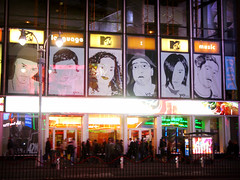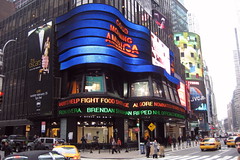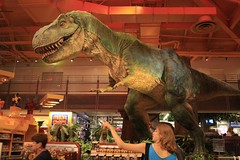South:
260: John's Pizzeria, offshoot of
the famous Greenwich Village brick-oven pizza joint.
258: Angus McIndoe is
a good place to spot
Broadway stars after their shows. Its investors include
The Producers' Nathan Lane, Matthew Broderick, Mel Brooks
and Thomas Meehan, along with Angela's Ashes' Frank McCourt.
248: The original location of Sardi's
(see below), from 1921 to 1927.
246: Originally the Erlanger, named for
producer A.L. Erlanger.
It saw the debut of Oklahoma, The King and I, The Pajama Game,
and Hello, Dolly!. The Producers
smashed box-office records here.
Helen Hayes Theatre
240: The was built in 1912 as the Little
Theater with only 299 seats for intimate drama; a balcony was added in 1917,
and it was renamed for the
"First Lady of the American Theater" in 1983.
Torch Song Trilogy and Dirty Blonde
debuted here.
234: The famous theater restaurant moved here
in 1927, displaced by the construction of the Erlanger.
Founder Vincent Sardi was noted for his generosity;
stage folk like James Cagney were able to eat here
on credit during lean times. Greta Garbo ate here
frequently in the 1940s. De Niro takes Jerry Lewis
here in The King of Comedy; Kermit eats here
in The Muppets Take Manhattan.
New York Times
The back entrance to New York's
leading establishment paper, relocated here starting
in 1913 from the tower that gave Times Square its name.
216: The site of Weber and Fields' Music Hall,
later the 44th Street Theater;
the Marx Brothers' Animal Crackers,
On the Town debuted here. During World War II,
the American Theatre Wing Stage Door Canteen fed and
entertained servicemen in the basement. There
was a
1943 musical based on and named for
the Canteen. The theater was demolished in 1945.
200-B: Ollie's, part of a mini-chain of
Chinese noodle shops
200: Carmine's,
popular Italian mini-chain, is
noted for its huge "family-style" portions.
This branch opened in 1992.
Paramount Building
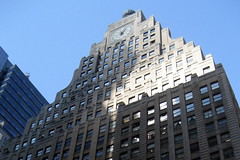
Corner (1501 Broadway): Built for the film company in 1927; the
step-like setbacks are intended to resemble
the mountain on the Paramount logo. Here was the
Paramount Theater, which was Frank Sinatra's
home base in the early 1940s, and a Beatles venue
in 1964; the space was
later the
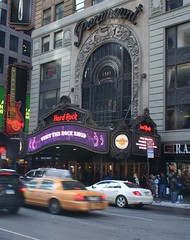 WWE New York, a wrestling-themed restaurant. It's now the
Hard Rock
Cafe, the theme restaurant that started them all;
this one was christened in 2005 with the smashing
of 100 guitars. On the northern end of the block
is the
Bubba Gump Shrimp Co., named for the
business in Forrest Gump. (Boy, I hated that movie.)
WWE New York, a wrestling-themed restaurant. It's now the
Hard Rock
Cafe, the theme restaurant that started them all;
this one was christened in 2005 with the smashing
of 100 guitars. On the northern end of the block
is the
Bubba Gump Shrimp Co., named for the
business in Forrest Gump. (Boy, I hated that movie.)
The superhero Captain Marvel was born on
the 22nd floor here in 1940, in the offices of
Fawcett Comics.
This was earlier the site of the Putnam Building,
which was used as a base by racketeer
Kid Dropper.
Involved in a gang war with another mob leader, the Kid
was shot and killed while being sent out of town with an escort
of 80 cops.
The Paramount Building has pre-recorded
chimes that play "Give My Regards to Broadway"
at 7:45 p.m. every day to remind theatergoers
that it's 15 minutes until curtain.
| 


